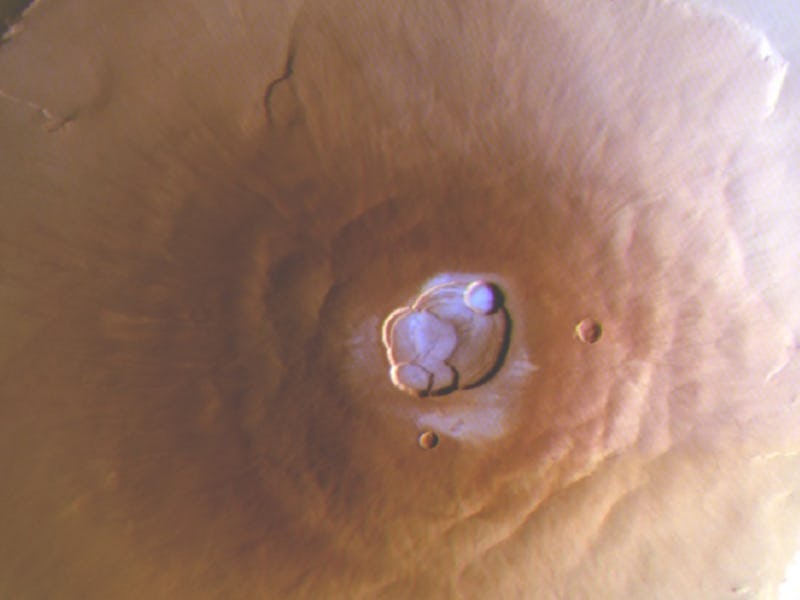In an Extremely Unlikely First, Scientists Found Frost On the Peak of Mars’ Volcano Olympus Mons
A team of scientists recently discovered frozen water in an unlikely place on Mars.

Rain will probably never fall on Mars’ giant volcano, Olympus Mons (our condolences to the MMC). But a glittering swath of frost covers the Martian mountaintop on chilly mornings, according to new research, suggesting that the planet has an active, if sparse, water cycle.
A team of scientists recently discovered frozen water in an unlikely place on Mars: 13.5 miles above the surface, nestled near the peak of our Solar System’s largest mountain, Olympus Mons (which is also a volcano, though its last eruption was 25 million years ago.) For a few hours each morning during the colder Martian seasons, huge patches of frost settle in the ancient calderas of Mars’s Tharsis Mountain range, which includes Olympus Mons. The recent study is the first time scientists have seen frost anywhere near the planet’s equator, and it could suggest new places to look for water and potential signs of life on Mars.
Brown University planetary scientist Adomas Valentinas and his colleagues published their work in the journal Nature Geoscience.
The frost is visible in blue in this image of Olympus Mons.
Frost-Capped Mountain Peaks in the Martian Tropics
Valentinas and his colleagues spent five years poring over data from an instrument called CaSSIS (Color and Stereo Surface Imaging System) aboard the European Space Agency’s Trace Gas Orbiter. In 2018, the scientists thought they had glimpsed frost in the high calderas of Olympus Mons and some of the other dormant volcanoes of Tharsis, and more data from the Mars Express Orbiter confirmed what they had seen. The team spent the next five years studying more than 30,000 images of the region, captured at different times of day and in different seasons, to piece together a record of how the frost came and went.
It turns out that during Mars’s colder months, a super-thin layer of frost forms at the peaks of the towering mountains and in their calderas — the collapsed craters formed by cataclysmic volcanic eruptions millions of years ago. The icy layer is only about as thick as a human hair, and it lasts just a few hours before it evaporates under the heat of the Martian Sun. However, it covers such a wide swath of ground that even that thin, short-lived frost layer contains about 150,000 tons of water, enough to fill 6 Olympic swimming pools. And in the mostly-dry environs of modern Mars, that’s a lot of water.
“We thought it was improbable for frost to form around Mars’s equator, as the mix of sunshine and thin atmosphere keeps temperatures during the day relatively high, at both the surface and the mountaintops — unlike what we see on Earth, where you might expect to see frosty peaks,” says Valentinas in a recent statement.
Valentinas and his colleagues suggest that there’s something about air circulation around the tops of the mountains and through the calderas that creates a microclimate that’s cool enough and humid enough to allow frost to form on cold mornings. Building computer simulations of how the frost forms and evaporates could help scientists understand Mars’s water cycle, such as it is, in more detail.